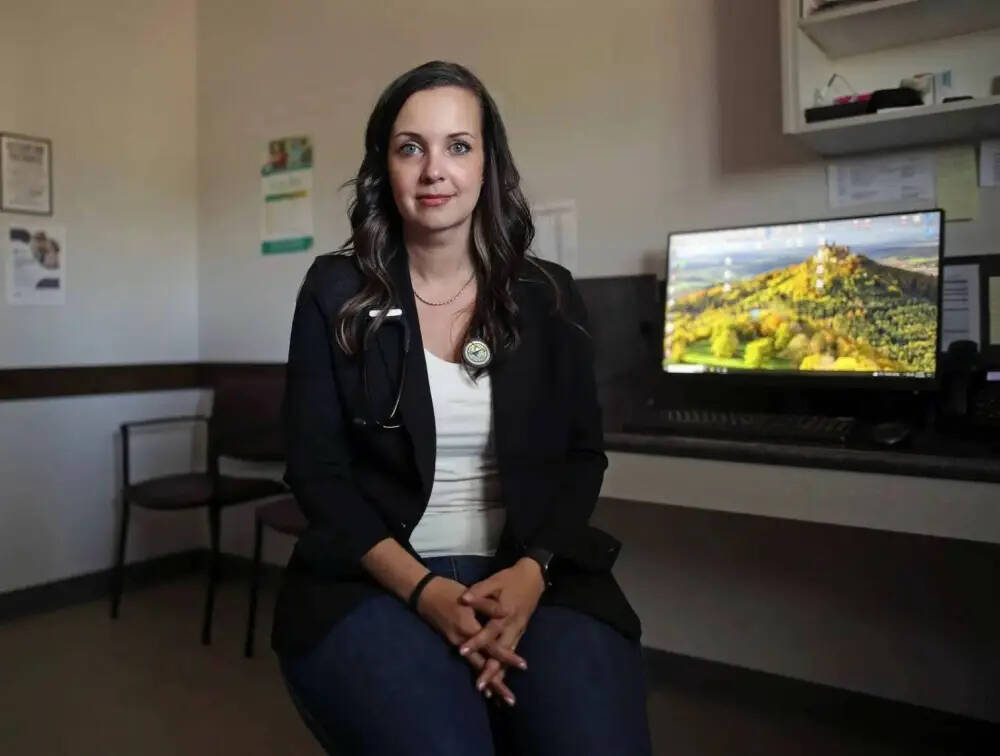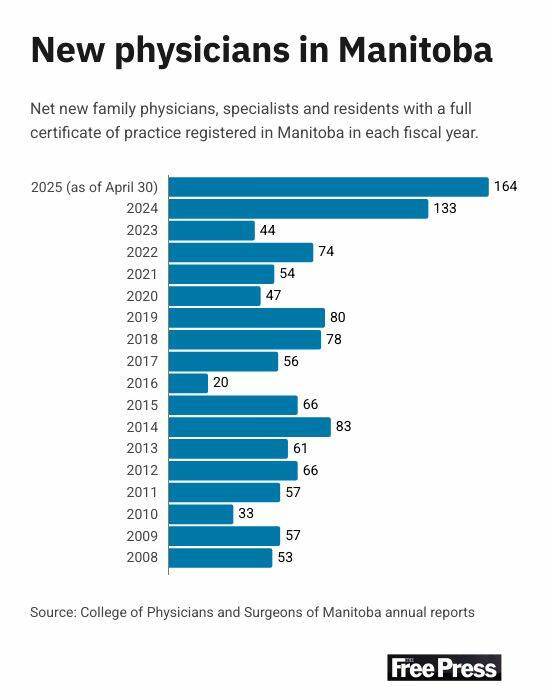Rise in international trainees helps Manitoba add 164 net new doctors
Doctors Manitoba applauds numbers amid shortage but worries more graduates leaving province than ever
Advertisement
Read this article for free:
or
Already have an account? Log in here »
To continue reading, please subscribe:
Monthly Digital Subscription
$1 per week for 24 weeks*
- Enjoy unlimited reading on winnipegfreepress.com
- Read the E-Edition, our digital replica newspaper
- Access News Break, our award-winning app
- Play interactive puzzles
*Billed as $4.00 plus GST every four weeks. After 24 weeks, price increases to the regular rate of $19.00 plus GST every four weeks. Offer available to new and qualified returning subscribers only. Cancel any time.
Monthly Digital Subscription
$4.75/week*
- Enjoy unlimited reading on winnipegfreepress.com
- Read the E-Edition, our digital replica newspaper
- Access News Break, our award-winning app
- Play interactive puzzles
*Billed as $19 plus GST every four weeks. Cancel any time.
To continue reading, please subscribe:
Add Winnipeg Free Press access to your Brandon Sun subscription for only
$1 for the first 4 weeks*
*$1 will be added to your next bill. After your 4 weeks access is complete your rate will increase by $0.00 a X percent off the regular rate.
Read unlimited articles for free today:
or
Already have an account? Log in here »
Manitoba added a record number of net new physicians over the past year, bolstering the ranks of a province that has one of the largest shortages in the country.
The number of registered family physicians, specialists and medical residents with a full certificate of practice reached 3,498 as of April 30, up from 3,334 on the same date last year — a net gain of 164.
The College of Physicians and Surgeons of Manitoba, the provincial regulator overseeing the practise of medicine, outlined the figures in its latest annual report on Thursday.
“The net gain is significantly higher than usual, which would be one of the big stand-out points,” Jeremy de Jong, director of registration with the college, said.
“We are seeing a marked rise in internationally trained physicians in the province.”
Overall, 302 new physicians registered in Manitoba over the fiscal year, while 138 retired or left. Currently, 1,672 family physicians, 1,754 specialists and 72 residents working across the province, the report said.
It marks the second second consecutive year Manitoba set a record for the number of net new doctors, according to a Free Press review of annual reports dating back to 2008 (the earliest records available).
Manitoba added 133 net new physicians in the 2023-2024 fiscal year, which was the highest number since 2014, when the province welcomed 83. Between 2008 and 2023, Manitoba saw an average net increase of 58 physicians per year, previous reports show.
The net increase was driven largely by out-of-province and international medical graduates, who represented about 77 per cent of all new registrants, the latest report said.
Doctors Manitoba, a group representing physicians in the province, has consistently called for increased recruitment and retention efforts in the province, which has fought physician shortages for years.

“We are very encouraged by the record number of new physicians practising in Manitoba last year, a step in the right direction toward reducing our physician shortage,” Doctors Manitoba president Dr. Nichelle Desilets said in an email statement.
“It shows that investments over the last four to five years to recruit more are paying off at a time when Manitoba is still experiencing the second biggest physician shortage in the nation.”
Jurisdictions across Canada have been ramping up efforts to recruit internationally trained doctors amid growing medical demands. In Manitoba, the province has responded by streamlining parts of the registration process for qualified physicians, de Jong said.
The college is expecting a surge of U.S.-trained doctors as a result of some of those changes, he said.
Manitoba graduates made up the remaining 23 per cent of new registrants, the lowest proportion in more than 15 years. Family physicians represent 70 per cent of new hires, while specialists account for the remaining 30 per cent, Doctors Manitoba said.
“While the report is encouraging overall, we do see fewer specialists being recruited, and we see fewer Manitoba graduates choosing to stay and practise here,” Desilets said.

Tim Smith / The Brandon Sun files
President of Doctors Manitoba, Dr. Nichelle Desilets, called the increase: “A step in the right direction toward reducing our physician shortage.”
“Manitoba graduates know our system the best, so this demands a closer look by the health system to see what we can do to keep more Manitoba-trained physicians in the province.”
Physicians trained in Manitoba still form 49 per cent of the province’s doctors; 16 per cent come from elsewhere in Canada, while 35 per cent are internationally trained.
De Jong said family physicians are the type of doctors most needed in Manitoba right now. Some specialty positions are appropriately staffed, while others — including psychiatry, surgery, internal medicine and neurology — have shortfalls, he said.
Improving retention is critical for securing stability in the health system, he said.
“One big question we have with these numbers: if the net gain has a large proportion of individuals recruited from out of the province, how long are they going to stay?”
The college launched a physician survey this week to seek answers, de Jong said.
“We will be analyzing that data to figure out what causes people to stay, what causes people to think about leaving and what can we do to make changes to start seeing those retention numbers improve.”

The number of Manitoba graduates registering for work in the province is not the sole indicator of healthy retention, de Jong said, explaining many people travel from out of province to attend school with the intention of returning home after completing their studies.
In total 2,632 doctors practise in Winnipeg, while 333 work in northern regions, 279 work in eastern regions and 248 work in western Manitoba. Six other physicians do not have a primary practise location, the report shows.
About 64 per cent of the net new doctors are working in the capital city, while 36 per cent are in rural areas, Doctors Manitoba said.
Speaking at an unrelated news conference on Thursday, Premier Wab Kinew celebrated the new hires.
“We were elected to fix health care. The first part of fixing health care means getting more people working at the bedside,” Kinew said.
Health Minister Uzoma Asagwara said the government removed red tape for internationally trained doctors and also expanded opportunities for homegrown physicians, including adding seats to the University of Manitoba Brandon campus.

MIKE DEAL / FREE PRESS
Minister of Health, Seniors and Long-Term Care, Uzoma Asagwara: “It doesn’t fix the shortage overnight, but it’s real progress.”
”It doesn’t fix the shortage overnight, but it’s real progress and proof that our recruitment and retention plan is working,” Asagwara said in an email statement.
— with files from Joyanne Pursaga
tyler.searle@freepress.mb.ca




